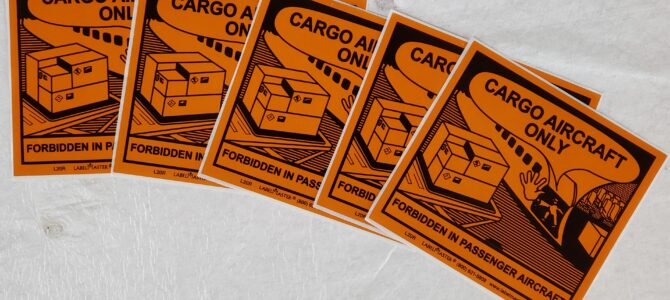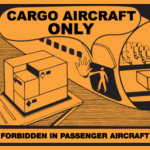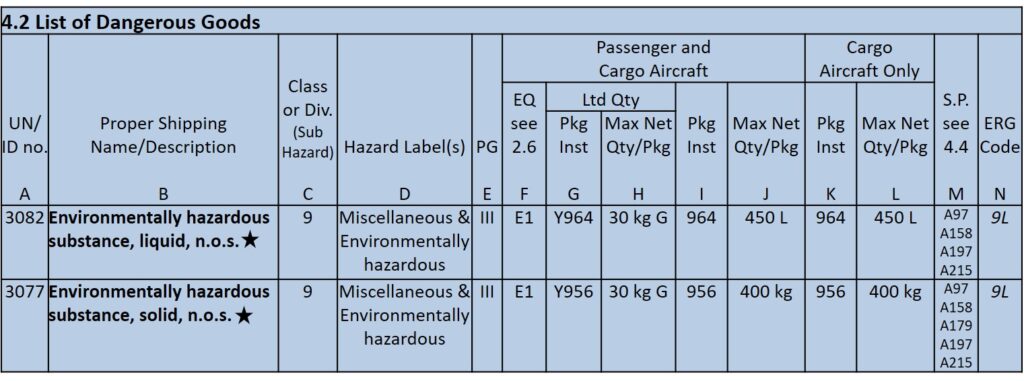Purpose:
The purpose of this article is to explain the use, restrictions, requirements, & limitations for the display of the Cargo Aircraft Only label for the air transport of dangerous goods.
Introduction:
Perhaps the most unusual in appearance of all hazard communication used by the transportation regulatory agencies is the Cargo Aircraft Only label. Black letters and images on an orange background. An image of a passenger aircraft (notice the seats?) with a cartoon human figure. The human figure has an outlandishly enlarged hand preventing a pallet of dangerous goods from being loaded on the aircraft. To further convey the point, emanating from the human character is a speech bubble that reads “CARGO AIRCRAFT ONLY”. And, at the very bottom of the label, just to ensure we got the point, it reads: “FORBIDDEN IN PASSENGER AIRCRAFT”. Despite, or perhaps because of, its “cartoony” imagery, this is the hazard communication used by international agencies and USDOT/PHMSA to indicate a hazardous material or dangerous good that is forbidden as cargo on a passenger aircraft and must be transported in a cargo aircraft only.
|
Daniels Training Services, Inc. 815.821.1550 |
Before we begin…
- The Pipeline and Hazardous Materials Safety Administration within the U.S. Department of Transportation (USDOT/PHMSA) creates and enforces the Hazardous Materials Regulations (HMR) for the transportation of hazardous materials (HazMat) by all modes (motor vehicle, rail, vessel, & aircraft) to, from, or through the U.S.
- The Dangerous Goods Regulations of the International Air Transport Association (IATA) are produced in consultation with the International Civil Aviation Organization (ICAO) and are the guide recognized by the world’s commercial airlines for the transportation of dangerous goods by air.
- USDOT/PHMSA authorizes compliance with the IATA Dangerous Goods Regulations for the transportation of HazMat by air to, from, or through the U.S.
- The current version of the Cargo Aircraft Only has been in use since January 01, 2013 when it replaced a label with many similarities but lacking a clear message limiting the transport to cargo aircraft only.
- In use until December 31, 2012
- The HMR also make use of the Cargo Aircraft Only label. Its use under those regulations are not within the scope of this article.
- Regulations of the HMR specific to lithium batteries at 49 CFR 173.185(c)(1)(iii) allow for the use of alternative markings to the Cargo Aircraft Only label.
- The IATA Dangerous Goods Regulations identify two different types of labels:
- Hazard labels (7.2.3) indicate the potential hazards within a package.
- Handling labels (7.2.4) are used to convey additional information about the dangerous good or its handling restrictions. Handling labels are used alone or in addition to hazard labels. The Cargo Aircraft Only label is a handling label.
Scope and Applicability:
This article will address solely the use of the Cargo Aircraft Only label subject to Edition 63 (Effective January 1, 2022 to December 31, 2022) of the Dangerous Goods Regulations of the International Air Transport Association (IATA).
Specifications:
- An illustration of the Cargo Aircraft Only label showing its approved design and color is at Figure 7.4.B of the IATA Dangerous Goods Regulations.
- The minimum dimensions of the Cargo Aircraft Only label are 120 mm wide x 110 mm high. These dimensions may be halved for small packages of Division 6.2 Infectious Substances.
|
Contact me with any questions you may have about the transportation of hazardous materials by air, highway, vessel, or rail International and Domestic Daniels Training Services, Inc. 815.821.1550 |
Applicability (7.2.4.2):
The use of the Cargo Aircraft Only label – its applicability – depends upon the classification of the dangerous good, its quantity per package, the relevant packing instructions, and the presence of any State variations.
- The Cargo Aircraft Only label must be displayed on a package of dangerous goods if the package contains dangerous goods that are permitted only on cargo aircraft.
- For the dangerous good: UN1402, Calcium carbide, 4.3, PG I the word “Forbidden” appears in columns I (“Pkg Inst” for Packing Instructions) and J (“Max Net Qty/Pkge” for Maximum Net Quantity per Package) of the List of Dangerous Goods. However, a Packing Instruction number and Maximum Net Quantity per Package are displayed in columns K and L applicable to Cargo Aircraft Only. Therefore, when offered for transport by air a package containing this dangerous good must display the Cargo Aircraft Only label.
- The Cargo Aircraft Only label must be displayed on a package of dangerous goods if the package contains a quantity of dangerous goods that exceeds the maximum net quantity per package in column J.
- The dangerous good: UN1264, Paraldehyde, 3, PG III is permitted for transport on both passenger and cargo aircraft. Its maximum net quantity per package for passenger aircraft is 60 L; therefore, a package containing 61 L of paraldehyde is not permitted for transport aboard a passenger aircraft. However, the maximum net quantity per package for transport by cargo aircraft only is 220 L and therefore allows for this quantity of paraldehyde per package. Therefore, when offered for transport by air a package containing more than 60 L of paraldehyde carbide must display the Cargo Aircraft Only label.
- The Cargo Aircraft Only label must be displayed on a package of dangerous goods if a State variation requires it to be labelled and transported Cargo Aircraft Only when normally permitted on as cargo on a passenger aircraft.
- State variations of the USDOT/PHMSA (USG-02, USG-10, & USG-13) forbid the transport of certain dangerous goods on passenger aircraft even if the package is permitted to be transported on passenger aircraft per the IATA Dangerous Goods Regulations.
Q: If a State variation requires the display of the Cargo Aircraft Only label, may that package be transported as cargo on a passenger aircraft outside the jurisdiction of that State?
A: Yes. Per 8.1.6.5.3, if the IATA Dangerous Goods Regulations permit its transport as cargo on a passenger aircraft and it is solely a State variation that requires it to be transported by cargo aircraft only, then outside the jurisdiction of the State with the variation it may be transported as cargo on a passenger aircraft under the following conditions:
-
- This text must be included in the Additional Handling Information box of the Shipper’s Declaration for Dangerous Goods: “This shipment may be carried on passenger aircraft outside <<State>> jurisdiction.”
- The Cargo Aircraft Only label must be removed or obliterated before the package is loaded onto a passenger aircraft. If the package is subsequently carried inside the jurisdiction of the State with the variation, the label must be re-affixed.
- The Cargo Aircraft Only label should not be displayed on a package of dangerous goods if the packing instruction number and the maximum net quantity per package are the same for passenger and cargo aircraft in the List of Dangerous Goods.
- UN3082, Environmentally hazardous substance, liquid, n.o.s. has the same packing instruction number (964) in columns I and K and the same maximum net quantity per package (450 L) in columns J and L.
- The Cargo Aircraft Only label must not be displayed on a package that is packed according to the passenger aircraft limitations of columns G and H (for limited quantity) or columns I and J even when it is included on a Shipper’s Declaration for Dangerous Goods marked as “Cargo Aircraft Only” because of other packages in the consignment.
- A package containing 10 L of Chromic acid solution is not permitted as cargo on a passenger aircraft and must display the Cargo Aircraft Only label. A package containing 5 L of Chromic acid solution is permitted as cargo on a passenger aircraft and is not required to display the Cargo Aircraft Only label. If combined in one consignment, the Shipper’s Declaration for Dangerous Goods must be marked to indicate it is Cargo Aircraft Only (due solely to the 10 L package of Chromic acid solution). However, per 7.2.4.2 and 8.1.6.5.2, it is a violation to display the Cargo Aircraft Only label on the 5 L package of Chromic acid solution.
|
Like this article? Subscribe to my Monthly Newsletter No marketing emails! |
Conclusion:
It is no exaggeration to say that the Cargo Aircraft Only label is the most recognizable and the most important form of hazard communication used for the air transport of dangerous goods. Make certain you are familiar with the situations you must use it, the times you should not use it, and the times you must not use it.






